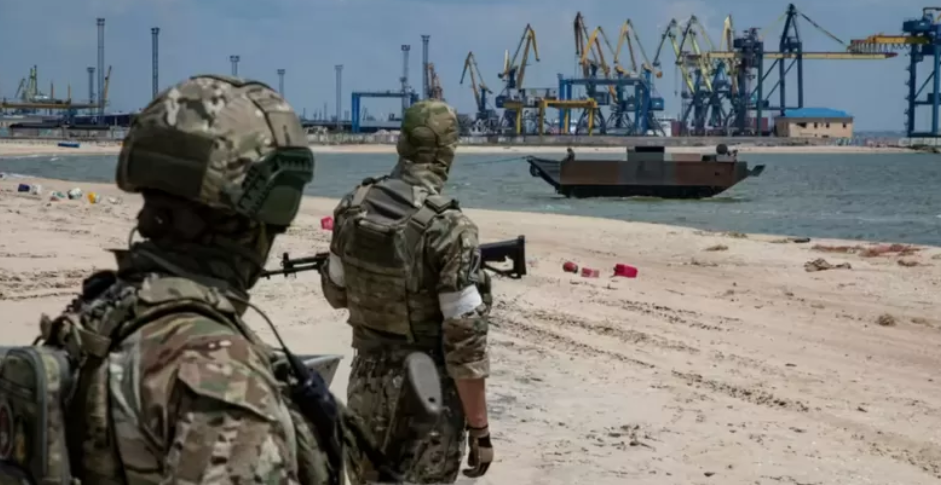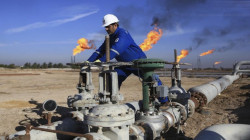Ships going dark: Russia’s grain smuggling in the Black Sea

Shafaq News/ Earlier this month, a ship called the Fedor steamed south through the Bosphorus before stopping at Bandırma, a Turkish port just south of Istanbul. The Russian bulk carrier was hauling 9,000 tonnes of corn, which it delivered to local buyer Yayla Agro, one of Turkey’s leading producers of pulses, grains and rice.
According to the official documentation, the cargo had come from a small port in Russia on the Black Sea coast. Given that there are no sanctions on foods from Russia, a major source of grains to the world, this would not present any legal problems.
But in reality, the voyage appears to be part of an apparatus that uses commerce in the Black Sea to evade other sanctions on Russia — and potentially to smuggle goods out of Ukraine.
The Financial Times has established that the ship actually picked up the cargo in Sevastopol in Crimea, the region illegally annexed by Russia in 2014. Photographs taken by Myrotvorets, a Ukrainian activist group, show the Fedor in the port of Sevastopol on June 12.
Using photos from Planet Labs, a satellite photography platform, the Financial Times has corroborated this visit. The photos show it moored at the Aval terminal, which loads ships with grains — including corn. The satellite photographs appear to show the ship being filled.
Even before Russian troops poured into Ukraine in February, shipping goods out of Crimea was illegal for many companies: the region has been covered by a patchwork of sanctions since it was annexed in 2014. The registered owners of Sevastopol’s grain terminal have been directly targeted by US sanctions for being a subsidiary of a Russian state-owned enterprise, United Shipbuilding Corporation. Companies trading with the occupied territory also risk action by Ukrainian prosecutors.
But in recent weeks, the shipments have become even more controversial after Ukrainian authorities claimed Crimean ports, including Sevastopol, are being used to export grain looted from their country, primarily from areas of the south-east that have been occupied by Russian forces this year. In early June, Russian state media acknowledged that grain was being sent from Melitopol, in the occupied south of Ukraine, to be exported from Crimea.
There is no evidence that the grain being shipped out of Crimea on the Fedor or other ships analysed by the FT has been stolen from parts of Ukraine now occupied by Russia.
However, there is a pattern of activity that indicates a rise in smuggling from Crimea. Although there is little historical data about volumes of exports through the port, Ukrainian activists who monitor the port say they have seen a rise in grain traffic at Sevastopol in May and into June compared with previous years.
FT analysis of satellite photographs, combined with port records, suggests that in May alone, around 140,000 tonnes of grain were exported from the Sevastopol terminal in eight separate shipments. This total flow is equivalent to about 6 per cent of known Russian grain exports during the month, according to shipping data platform Sea/. Given that Russia is one of the world’s biggest food exporters, that represents a substantial volume of grain being shipped out of a port that is under international sanctions.
Of the eight vessels photographed in Sevastopol, one could not be identified or tracked. Four were sent to Syria, with customs and port declarations suggesting this flow was of about 90,000 tonnes. The other three — carrying about 43,000 tonnes — went to Turkey.
The evidence from Sevastopol is supported by the activity at Port Kavkaz in Russia, along the coast from Crimea, which industry executives say is a key location for enabling the smuggling of goods from the region. Although it is only a modest port, it has also seen a significant and unseasonal increase in declared exports in recent months.
The listed owners of the Fedor and the Aval terminal did not respond to requests for comment. Yayla, the Turkish company that bought the shipment on the Fedor, said it believed the cargo had come from a port in Russia and was therefore not subject to sanctions.
The voyages demonstrate the relatively straightforward steps that Russian companies operating in the Black Sea can use to evade the patchy sanctions applied to the country — from switching off devices that report ships’ positions at sea to faking paperwork.
Shipping experts believe that the sanctions-busting through Crimea underlines how hard it is to prevent smuggling of grain and other, looted, goods from Ukraine. It also highlights the potential difficulties of enforcing sanctions on the export of other Russian commodities, such as coal and steel through the Black Sea.
Russia has announced it is beginning to reopen other Black Sea ports that have been occupied, including Berdyansk and Mariupol, and has been accused of using techniques deployed in the illegal grain trade to smuggle out steel seized by Russian forces.
According to Matthew Wright, a senior freight analyst at Kpler, a commodities analytics company, the shipments that have come from Sevastopol in recent weeks are “perhaps the most blatantly illegal grain entering the market — maybe stolen, definitely from a sanctioned source and photographed in the act”.
Strategic location
When Russia annexed Crimea in 2014, it gained complete control of the naval base in Sevastopol that had long been the home to its Black Sea fleet. But Moscow has also sought to develop the port as a commercial enterprise. Several of the businesses integral to the shipping of grain from Crimea are subsidiaries of Russian state enterprises.
Russia wants to encourage trade through Sevastopol to integrate Crimea into the rest of the country and to build international acceptance of its occupation of the region. The FT has identified grain exports from Crimea that took place prior to this year to Syria, a Russian ally that disregards US sanctions, as well as to Libya and Turkey.
According to one Russian grain exporter, it is quick and cheap to move grain through Crimea because of its infrastructure and position. With a deepwater port that can accommodate large ships, he says, Sevastopol is “without false modesty, by far the best” port from which to export grain.
Since the invasion began, at the end of February, Sevastopol has become the nearest major port to much of newly occupied parts of Ukraine. Truckloads of grain have been reported heading to Crimean depots and silos from occupied Ukrainian territory.
Government and industry officials say that it is almost impossible to trace whether any shipments contain grain that has been stolen from Ukrainian farms, because it can easily be combined with grains from legal sources. According to one European official, if a company takes crops from Ukraine and “then mixes it with Russian grains and exports it from the Russian harbours, it is very difficult to follow up”.
But ships exporting grain from Crimea have used practices that were largely designed to evade sanctions. Under international law, ships are supposed to operate transponders, devices that automatically report their location and route to other vessels and ports, unless they face exceptional circumstances. However, in a number of cases tracked by the FT, ships in the Black Sea turned off their transponders — often when they were approaching Crimea.
Doing so makes it much more difficult to both trace journeys and to catch ships whose paperwork is incorrect — allowing vessels that picked up cargo from a port under sanctions to claim the goods were loaded elsewhere.
Yayla declined to reveal its supplier, but says its contract — plus the bill of lading, certificate of origin and other cargo documents — stated that the port of loading was Port Kavkaz, just down the coast from Crimea. Grain shipments that originate from Russian ports such as Port Kavkaz are not covered by sanctions.
The three ships identified by the FT as coming from Crimea to Turkey in May also listed Port Kavkaz as their cargo’s origin. The three vessels were brought to the attention of the Turkish authorities by Ukrainian officials. A Turkish official says that customs officers did the “necessary screening process and informed us that the declared origin of the cargo was Russia”.
The official adds: “This is based on the documentation issued by the Russian authorities. It is technically very difficult to determine the geographic origin of grain.” Industry figures in Turkey have told the FT that port officials in the country are well aware of the possible Crimean origin of grain shipments listed as coming from Port Kavkaz.
Grain industry executives say that Port Kavkaz also plays another important role in efforts to evade sanctions because it is a hub for ship-to-ship transfers of goods, using anchorages outside the port. Loading at sea has legitimate uses, especially given that Port Kavkaz is not capable of admitting large vessels. But it can also enable smuggling, since it makes it particularly difficult to establish where a cargo was initially loaded.
One potential use of this practice is for ships that picked up cargo from Crimea or from a business that was subject to sanctions to then shift their load to another vessel while still at sea.
A Russian grain exporter says that one particular Port Kavkaz anchorage has been used for several years as a favoured spot for laundering grain loaded in Crimea, using ship-to-ship transfers.
“You would absolutely use ship-to-ship to obscure the source of dry cargo,” says Wright, the shipping analyst. “It’s pretty much the standard behaviour for any illicit activity.”
Satellite photography from Planet Labs shows there is currently a significant amount of ship-to-ship transfer happening in the Port Kavkaz anchorage. Although the practice stopped for a month at the start of the war, satellite photographs from late May showed seven large ships being filled by, or emptied into, smaller ships simultaneously.
The FT has also identified journeys in which ships loiter in Port Kavkaz with their transponders on before or after heading to Crimea to be filled — creating the impression that they were loaded in the Russian port. In some cases, port paperwork has shown ships reporting to Russian authorities that they were filled in Sevastopol but telling other governments they were loaded in Port Kavkaz.
Although there is no direct evidence that any of the grain exported from Port Kavkaz in recent weeks has been stolen, there has been a substantial increase in the use of the port this year. According to vessel tracker Shipfix, 576,000 tonnes of agricultural commodities were declared as coming from Port Kavkaz in May. This is an extremely large flow at this time of year, albeit after several months of war-interrupted trade.
In May, Port Kavkaz accounted for the equivalent of 28 per cent of total Russian grain exports, compared with a monthly average for the four previous years of about 11 per cent.
Delicate diplomacy
The claims of grain smuggling through the Black Sea create an acute dilemma for the western governments that have imposed sanctions on Russia. They do not want to aggravate the global food crisis the war has helped produce, but they are reluctant to turn a blind eye to smuggling.
Last year Russia and Ukraine accounted for more than one-quarter of the world’s grain exports and just under one-third of all wheat exports, according to the UN Food and Agricultural Organization. Black Sea wheat has historically been particularly important in north Africa and the Middle East.
“Ideally, we need Russia and Ukraine to supply grain to the rest of the world,” says Chad Bown, a senior fellow at the Peterson Institute, a think-tank in Washington. “But we do not want Russia to make a lot of money from it. And we definitely do not want it to make any money from grain it has looted from Ukrainians, nor the places the Russians have occupied.”
G7 foreign ministers last week discussed a UN effort to enable shipments of Ukrainian grain from the port of Odesa, which is not occupied by Russia but has been closed since the start of the war. However, a senior US official says the administration is sceptical about how far the talks can go.
The practices being used to export from Crimea also reveal how Russian companies might evade the broader net of sanctions they now face. Unlike the UN-imposed measures on Iran, the sanctions on Russia are driven largely by western governments. This means their impact is more patchy.
Turkey’s president, Recep Tayyip Erdoğan, whose nation controls the two crucial waterways linking the Black Sea to the Mediterranean, has sought to perform a delicate balancing act since the invasion. The Nato member state has supplied armed drones to Kyiv and limited the use of its waters and airspace by the Russian military. But Erdoğan has also tried to avoid damaging his close relationship with Vladimir Putin and declined to sign up to the sanctions unleashed by western states.
A 2017 directive by the Turkish Chamber of Shipping advised ports to turn away ships from Crimea upon the request of the Ukrainian chief prosecutor. Last week, Mevlut Cavusoglu, the Turkish foreign minister, said Ankara was investigating claims that grain looted from Ukraine had come to Turkey and would “not allow these goods to come to us”.
But Turkish officials have been reluctant to stop ships that Kyiv claims are carrying stolen grain, citing a lack of evidence. Başak Aldı from the Istanbul-based law firm AKT says vessels sailing from Crimea could face administrative fines, but these penalties only apply if the vessel comes directly from Crimean ports without an intervening stop.
Ankara’s ambivalent stance has caused concern in Washington and the EU, where officials are eager to ensure Turkey does not become a centre of sanctions evasion. Deputy US Treasury secretary Wally Adeyemo visited Turkey last week to discuss sanctions co-ordination with senior Turkish officials. Ukraine is also working to create a legal mechanism to ensnare international buyers of grain shipments from Crimean ports.
Even if Turkey does not apply sanctions, there is still serious risk for large companies doing business with entities sanctioned elsewhere. Aline Doussin, a partner at Hogan Lovells, says that if a company in a country without sanctions on Russia were revealed to be engaged in trade prohibited by the UK, EU or US, “they might find that large multinational companies from those places stop trading with them over concerns that they were indirectly trading with sanctioned entities”.
Yayla, which exports its products across the world, confirmed they had bought the shipment on the Fedor but added that it was an “absolute priority” to operate “within ethical rules and carry out trade in accordance with international law”.
The company says it will investigate the allegations presented by the FT, adding: “It is our obligation as a company to check whether the company we are trading with is on the international sanctions list . . . and to ensure that the contract is fulfilled in accordance with the provisions of the contract we have made.”
More ports opening
As the war continues, the potential for Black Sea commerce to evade sanctions could grow — as will the opportunity for selling other goods that have been looted.
On grain alone, Ukraine claims to have had 500,000 tonnes stolen. One example involves the Lady Augusta, a general cargo ship which satellite photographs show is stranded in the occupied city of Mariupol, where it docked before the outbreak of war to pick up 6,500 tonnes of wheat. It has now been claimed by the “Donetsk People’s Republic”, the Russian-run separatist group.
Tetiana Alaverdova, commercial director of HarvEast, the company which was filling the vessel, says that since February it has lost control of 52,000 tonnes of grains that were in areas now controlled by Russia. “We heard that some of the grain in our stockpiles there disappeared. But in what volumes, we don’t know,” she says.
In addition to grain that has been stolen, some Ukrainian farmers in occupied areas have been forced to sell their crops very cheaply. Masha Belikova, a Dnipro-based grain analyst for Fastmarkets Agricensus, says traders reported Russian businesses were buying grain in the occupied regions at knockdown prices.
Earlier this month, before a recent price fall, wheat that buyers said cost $192 a tonne in safer central Ukraine could be bought for around $90 to $100 in occupied areas.
The European market price for wheat is currently just under $370, meaning that this trade can be enormously lucrative. Yayla said that the amount it paid for the Fedor shipment was in line with market prices.
The potential for looted goods to be resold goes beyond grain. At the Azovstal steel plant in Mariupol, there were about 234,000 tonnes of metal on site prior to the invasion, worth roughly $148mn. Officials with Metinvest Holdings, which owns the steel, say it is all now under Russian control.
The company says it has been able to track at least 2,500 tonnes shipped from Mariupol to Rostov-on-Don in Russia.
“Our analysis shows us that the most likely [ultimate] destinations might be countries in Asia and in Africa and there is a small chance of some of the goods, namely slabs, going into Europe [because] slabs are not under the trade embargo,” says Svitlana Romanova, Metinvest’s chief legal officer.
Romanova says Metinvest has filed criminal complaints with the Ukrainian government and is trying to pursue other avenues, but there is no clear legal path to do so.
The theft of the steel signals what could become a growing problem for sanctions enforcement: the opening of more occupied ports. At least three ships have entered the port of Mariupol to load the stolen steel, according to Ukrainian officials in Donetsk. This claim is supported by satellite photography.
Alexander Saulenko, the Russia-imposed district governor, has also stated that the port of Berdyansk will soon start exporting grain from occupied Ukraine.
“It’s 100 per cent that the grain will be sent from here [through Berdyansk],” Saulenko told journalists. “There is quite a lot of grain in the district. Since we will soon have a new harvest and need to free up the warehouses, something needs to be done with the existing grain. Farmers also need to sell it in order to earn money . . . We have the prospects of signing contracts with Turkey.”
Sevastopol port has continued to be busy throughout June, with further shipments to Turkey. At around midday on Tuesday last week the Fedor passed Istanbul and travelled north through the Bosphorus into the Black Sea. The ship’s transponder was then switched off. Its last reported position suggests the Fedor was sailing to Port Kavkaz.
Source: The Finacial Times





